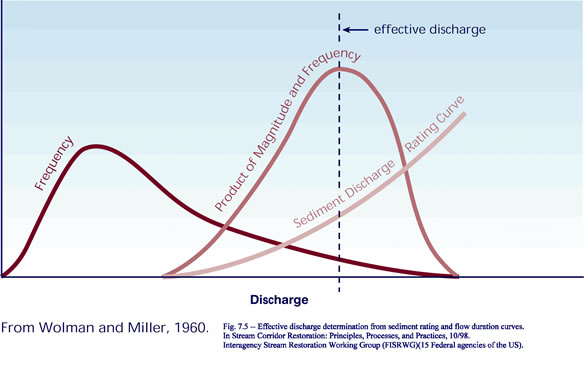
| glossary | menu | Normal | lg | hc | 4.) Geomorphologic Classification Systems > Classifying Stream Effective Work |
| < Previous | 1 | 2 | 3 | 4 | 5 | 6 | 7 | 8 | 9 | 10 | 11 | 12 | 13 | 14 | 15 | 16 | 17 | 18 | 19 | 20 | 21 | 22 | 23 | 24 | 25 | 26 | 27 | 28 | 29 | 30 | 31 | 32 | 33 | 34 | 35 | 36 | 37 | Next > |
Classifying Stream Effective Work

Stream effective work is a method for classifying channel forming flows of water and sediment. This classification examines the product of the frequency of various discharges, Q, and the sediment-discharge rating curve.
Wolman and Miller proposed this classification to understand the relative importance of various discharges on channel formation. While all flows in a river act to remove sediment and carve a channel, the most effective flows theoretically are those with the combined greatest frequency and greatest sediment load. Many FGM studies have demonstrated that the most effective channel forming work coincides with the Bankfull flow regime. For flows greater than Bankfull, the flood waters spill over the banks and into the Floodplain, and they have a relatively low shear force in this environment. Flows less than Bankfull have a lower depth than Bankfull, and have less shear force. It should not be presumed, however, that Bankfull flow is the same as the channel effective discharge, given the complexity of sediment discharge relations.
Image courtesy of FISRWG
| < Previous | 1 | 2 | 3 | 4 | 5 | 6 | 7 | 8 | 9 | 10 | 11 | 12 | 13 | 14 | 15 | 16 | 17 | 18 | 19 | 20 | 21 | 22 | 23 | 24 | 25 | 26 | 27 | 28 | 29 | 30 | 31 | 32 | 33 | 34 | 35 | 36 | 37 | Next > |